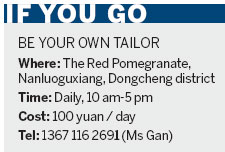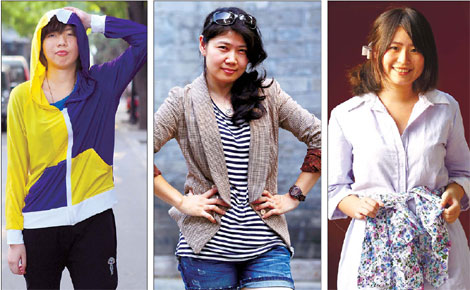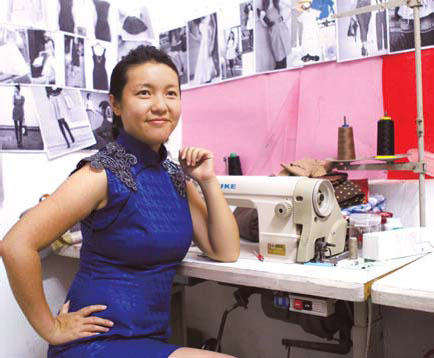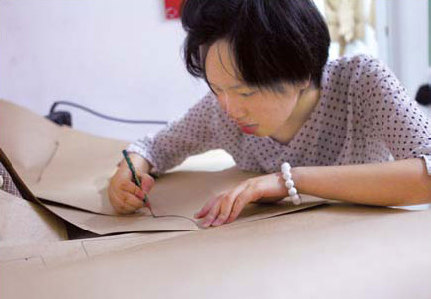Life
Amateur tailors make their own unique threads
By Li Yue'an (China Daily)
Updated: 2010-07-27 07:51
 |
Large Medium Small |
|
|
A growing number of young Beijingers, sick of their peers' attraction to brand-name clothing, are picking up needles and learning to sew outfits, Li Yue'an reports
It seems that for some Beijingers, the weekends are an undeclared fashion contest. Women passionately join the unofficial competition and dress themselves in today's most popular and pricey brands. But in this silent "war of tags", few knew what to make of Wang Yuxi, a 19-year-old university student from Xiamen, as she recently strolled down Nanluoguxiang in a uniquely fitted floral dress that bore no brand at all. It was a dress that she had designed and made.
"I love to make clothes, I am learning how to sew for fun. I am going to make clothes for myself and my friends," said Wang, standing in her self-made dress, posing for a friend's photos.
"Sewing makes me feel accomplished. I have completed three lessons and I made this dress today. I'm going to come and learn as often as I can," she said.
When Wang is not busy with her summer internship, she is in Nanluoguxiang, soaking up the popular hybrid of the old Beijing hutong atmosphere and modern urban culture, and attending sewing classes at the Red Pomegranate.
|
|
The Red Pomegranate is a sheltered courtyard house in Qianyuanensi alley, which branches east off Nanluoguxiang.
The sewing teacher, Gan Youling, started the class early this year. Holding a degree for fashion design, the 20-something has worked as an assistant designer and trainer. She caps her classes at only five students.
Gan's students generally are not interested in pursuing a tailoring career. They include office workers, Chinese and overseas students. Most of them come from comfortable middle-class backgrounds and many are learning just for fun. The class costs 100 yuan per person.
Gan says she expects the number of young Beijingers wanting to learn to sew will only increase.
"I definitely feel the trend to learn the craft is growing among the white-collar workers", she said.
Zhang Jingzhou, a 37-year-old computer programmer, has spent two months' worth of weekends in the sewing class.
"All I knew was how to write programs," Zhang said with a smile.
"I want to learn something artistic and something I can do with my hands instead of computers."
"I like this class because it is small, that means the teacher can pay a lot of attention on me individually."
Zhang has so far made skirts, dresses, jackets and pants.
For Deng Baoyi, who has come all the way from Shenzhen to spend part of her summer vacation here, the sewing class would be an unforgettable highlight of her trip.
"I made this and I'm going to wear it now," said the 17-year-old as she held up a skater-styled, zip-up hoodie, half purple, half lime green.
|
|
"It is really hard to find a color combination like this in clothes shops."
Deng, who found the sewing class on Douban.com, said she is interested in design and is thinking of going to college to study fashion design.
According to Gan, some of her students are from fashion design schools. Many of them, who study abroad in the UK, Australia and Canada, come to her class to get some hands-on tailoring experience.
"They told me they only learn theories and drawing in college, no one teaches them exactly how to cut and sew," said Gan.
Gan is proud to talk about her students.
"I have had students as young as age 14 and the oldest student I have had is in her 40s. She was Chinese with British nationality," said Gan.
She has even had a few boys here, who came to learn how to make ties and jackets.
When asked what students seek to learn from her, Gan said many of the younger students like to make popular Asian-styled dresses and tops, such as those from Japan and South Korea.
|
|
Older students prefer more traditional styles, such as cheongsam and mian'ao, the traditional Chinese cotton-padded jackets.
Also, some students want to make unique and unusual clothes for cosplay.
Sometimes the students get ideas from shopping. They may come across a pretty dress that costs a few thousand yuan and think that maybe they can try and make a similar one.
Gan carefully unfolds a little black dress made of silk and decorated with shiny sequins - a type typically seen in most fashion clothes shops.
"My student made this, not me," she said with pride.

The increasing popularity of the Red Pomegranate has started to attract foreign students to her class, Gan said.
An American undergrad studying in Beijing is looking forward to joining her in September.
Gan does not speak English, but she said she would love to pick up Korean in the future and her own sewing teacher, who runs the classes with her, is going to learn English.
Gan looks up at the wall and points at photos of Western models wearing low-cut shirts, mini skirts and punk-styled jackets.
"My students are going to be from everywhere and they want to make all types of clothes, I have to start learning foreign languages so I can keep up with the trends," said Gan.



